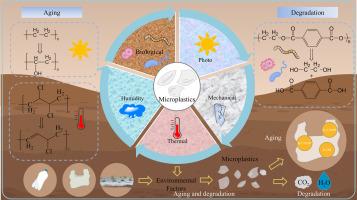Aging or degradation? Transformation mechanisms of microplastics in soil environments
IF 5
2区 农林科学
Q1 SOIL SCIENCE
引用次数: 0
Abstract
Soil serves as a primary sink for microplastics. This review explicitly focuses on the mechanisms underlying microplastic aging and degradation in soil environments, and the ecological toxicity arising from microplastic transformation. The fragmentation processes of different microplastics depend on the characteristics of their mechanical dynamics and microstructures. Mechanical disruption can result in surface cracking, fragmentation, and subsequent formation of smaller microplastic particles. Exposure to ultraviolet and infrared radiation under natural sunlight can accelerate the embrittlement, stiffening, and eventual fragmentation of microplastics. Thermal degradation of microplastics primarily involves high temperature facilitating the dissociation of chemical bonds between polymer molecules. This process is similar to photodegradation that refers to oxidative reactions following the breakage of polymer chains. The humidity stability of microplastics is influenced by the hydrophilicity of their functional groups. Microplastics that enter the soil environment undergo aging and degradation due to the chewing action of soil fauna and enzymatic erosion within their digestive tracts. The causal relationship between microplastic aging and degradation is further explored, providing a comprehensive understanding of how microplastics transform under soil conditions. This work supplements targeted data on microplastic behavior in soil ecosystems and establishes a foundation for studies on microplastic pollution management in terrestrial environments.

老化还是退化?微塑料在土壤环境中的转化机制
土壤是微塑料的主要储存库。本文重点综述了微塑料在土壤环境中的老化和降解机制,以及微塑料转化引起的生态毒性。不同微塑料的破碎过程取决于其力学动力学和微观结构的特点。机械破坏可导致表面开裂、碎裂,并随后形成更小的微塑料颗粒。暴露在自然阳光下的紫外线和红外线辐射会加速微塑料的脆化、变硬并最终碎裂。微塑料的热降解主要涉及高温促进聚合物分子之间化学键的解离。这个过程类似于光降解,指的是聚合物链断裂后的氧化反应。微塑料的湿稳定性受其官能团亲水性的影响。进入土壤环境的微塑料由于土壤动物的咀嚼作用和消化道内的酶侵蚀而发生老化和降解。进一步探讨了微塑料老化与降解之间的因果关系,全面了解了微塑料在土壤条件下的转化方式。这项工作补充了土壤生态系统中微塑料行为的针对性数据,为陆地环境微塑料污染管理研究奠定了基础。
本文章由计算机程序翻译,如有差异,请以英文原文为准。
求助全文
约1分钟内获得全文
求助全文
来源期刊

Applied Soil Ecology
农林科学-土壤科学
CiteScore
9.70
自引率
4.20%
发文量
363
审稿时长
5.3 months
期刊介绍:
Applied Soil Ecology addresses the role of soil organisms and their interactions in relation to: sustainability and productivity, nutrient cycling and other soil processes, the maintenance of soil functions, the impact of human activities on soil ecosystems and bio(techno)logical control of soil-inhabiting pests, diseases and weeds.
 求助内容:
求助内容: 应助结果提醒方式:
应助结果提醒方式:


